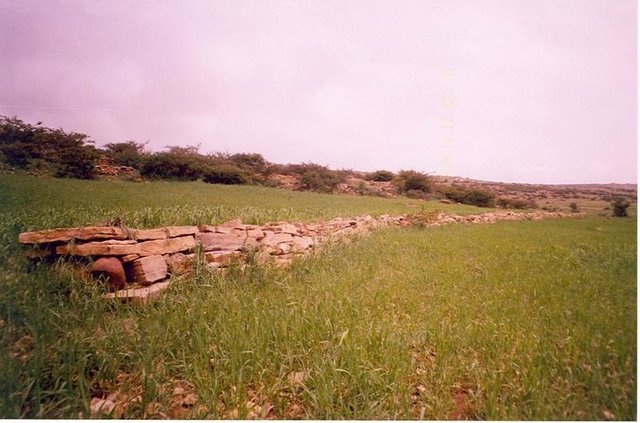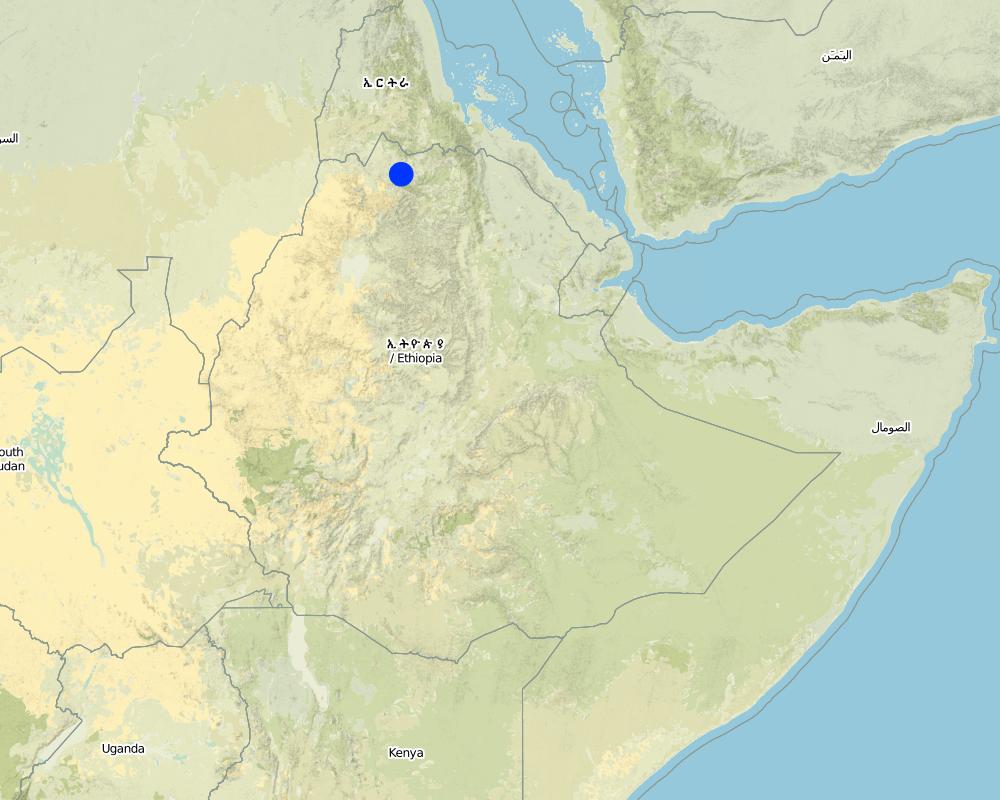Mass mobilization [Etiópia]
- Criação:
- Atualização:
- Compilador/a: Unknown User
- Editor: –
- Revisor: Fabian Ottiger
approaches_2376 - Etiópia
Veja as seções
Expandir tudo Recolher tudo1. Informação geral
1.2 Detalhes do contato das pessoas capacitadas e instituições envolvidas na avaliação e documentação da abordagem
Pessoa(s) capacitada(s)
Especialista em GST:
Wolde Gabriel
Tigray Bureau of Agriculture
Mekele
Etiópia
1.3 Condições em relação ao uso da informação documentada através de WOCAT
O/a compilador/a e a(s) pessoa(s) capacitada(s) aceitam as condições relativas ao uso de dados documentados através da WOCAT:
Sim
1.4 Referência ao(s) questionário(s) sobre tecnologias da GST

Stone bund of Tigray [Etiópia]
an allignment of stone along the contour line which stabilzes with grass species
- Compilador/a: Unknown User
2. Descrição da abordagem de GST
2.1 Descrição curta da abordagem
Mass Mobilization is an approach pursued to implement SLM technologies by organizing land users to undertake SLM activities without incentives being involved.
2.2 Descrição detalhada da abordagem
Descrição detalhada da abordagem:
Aims / objectives: It involves the process of mobilizing and organizing land users in the community (men, women, and youth) who are able-bodied to participate in SLM activities. Land users participating in mass mobilization are required to form SLM groups. Plan for SLM is made at the woreda level and then distributed to kebeles and or sometimes each kebele proposes plan, which is later approved by the woreda. Each member contributes free labor of 20 days every year to undertake land management technologies (past) and this contribution is increased to account for 40 days a year since 2009. The specific objective is to make land users participate in the management of land by implementing improved technologies. SLM measures control runoff and enhance rainfall water percolation. The approach involves organizing land users in SLM groups. Recently two groups are formed known as development team and a sub group called a work team. A development team group comprises 20-30 members while the work team group is 10-15 members. Women and men participate equally in the work groups and in leading the team. Activities undertaken by mass mobilization are mostly (80%) carried out on cultivated lands. Every day the group evaluates its activities. They also participate on the discussions of the plan.
Methods: There is a leader for each group and a production cadre for the groups at Kushet level (the lower administrative unit) who supervises activities of the groups. The groups also work on activities other than SLM. Problems addressed include: soil erosion, deforestation, declining productivity of land, low fertility of soil, low level of participation of the community in SLM activities. All land users in the community are expected to participate in the implementation of the technologies through the mass mobilization approach. The approach area is defined by administrative and as well as watershed boundaries. The Kebele and woreda administrators, woreda specialists and development agents coordinate the implementation and planning of the approach.
2.5 País/região/locais onde a abordagem foi aplicada
País:
Etiópia
Região/Estado/Província:
Laelay Adet, Tahtay A det, Naedir
Especificação adicional de localização:
Tigray, Ethiopia
Map
×2.6 Datas de início e término da abordagem
Indique o ano de início:
1992
2.7 Tipo de abordagem
- Tradicional/Indígena
2.8 Principais metas/objetivos da abordagem
The Approach focused mainly on SLM with other activities (Pond & dam construction and other water harvesting technologies.)
Aware, organize and initiate land users to participate in SLM activities that aim at controlling soil erosion, which causes land degradation and encouraging land users to contribute free labor for implementing the SLM technologies introduced. The specific objectives are: I) promote the awareness of land users on land degradation problem and II) show the importance of SLM measures which protect cultivated lands from erosion, retain soil moisture and improve fertility of soils.
The SLM Approach addressed the following problems: Soil erosion, deforestation, low productivity low soil fertility, low participation of community in SWC activities.
2.9 Condição que propiciam ou inibem a implementação de tecnologia/tecnologias aplicada(s) segundo a abordagem
Normas e valores sociais/culturais/religiosos
- Inibitivo
Many holidays are celebrated, and land users do not work on those days.
Treatment through the SLM Approach: Create awareness to work on those days.
Disponibilidade/acesso a recursos e serviços financeiros
- Inibitivo
Low income of the community
Treatment through the SLM Approach: Create other off farm activities
Quadro jurídico (posse de terra, direitos de uso da terra e da água)
- Propício
The existing land ownership, land use rights / water rights moderately helped the approach implementation: There is use right of land users.
Conhecimento sobre GST, acesso a suporte técnico
- Inibitivo
Widely spaced bunds do not control inter bund erosion.
Treatment through the SLM Approach: Training to be provided and also promote awareness.
3. Participação e papel das partes interessadas envolvidas
3.1 Partes interessadas envolvidas na abordagem e seus papéis
- Usuários de terra/comunidades locais
Tabias
Working land users were work equally divided between men and women. All community member participate equally in decision making.
- Governo nacional (planejadores, responsáveis pelas decisões)
BOA & Regional Adminstration
- Organização internacional
3.2 Envolvimento do usuários de terra/comunidades locais nas diferentes fases da abordagem
| Envolvimento do usuários de terra/comunidades locais | Especifique quem estava envolvido e descreva as atividades | |
|---|---|---|
| Iniciação/motivação | Passivo | public meetings: general assembly meeting called for awareness creation and informing about the development plan. |
| Planejamento | Passivo | Training: train SLM commission members. They plan the activities which is later endorsed by the general assembly. |
| Implementação | Participativo | Free labour: 20 days per year |
| Monitoramento/avaliação | Passivo | Measurements observation reporting: each activity is measured by the team leader and the other committee members. |
| Research | Nenhum |
3.4 Decisão sobre a seleção de tecnologia/tecnologias de GST
Especifique quem decidiu sobre a seleção de tecnologia/tecnologias a serem implementadas:
- Principalmente especialistas em GST, após consulta com usuários da terra
Explique:
Decisions on the method of implementing the SLM Technology were made by mainly by SLM specialists with consultation of land users
4. Suporte técnico, reforço das capacidades e gestão do conhecimento
4.1 Reforço das capacidades/ formação
Foi oferecida formação aos usuários da terra/outras partes interessadas?
Sim
Especifique quem foi capacitado:
- Usuários de terra
- SWC specialists, extensionists/trainers (1), politicians/decision makers (2)
Tipo de formação:
- Em exercício
- Agricultor para agricultor
- Áreas de demonstração
- Cursos
Assuntos abordados:
On desing, layout & construction methods of SWC technologies, moisture harvesting techniques.
4.2 Serviço de consultoria
Os usuários de terra têm acesso a um serviço de consultoria?
Sim
Especifique se foi oferecido serviço de consultoria:
- nas áreas dos usuários da terra
Descreva/comentários:
Name of method used for advisory service: House hold pack (PADET); Key elements: DA, Contact farmer; 1) Advisory service was carried out through: government's existing extension system; Extension staff: mainly government employees 2) Target groups for extension: land users, technicians/SWC specialists; Activities: Contrubuting free labour; Training, supervising, monitoring & evaluation, creating awarness in the co
Advisory service is quite adequate to ensure the continuation of land conservation activities
4.3 Fortalecimento da instituição (desenvolvimento organizacional)
As instituições foram fortalecidas ou estabelecidas através da abordagem?
- Sim, moderadamente
Especifique a que nível (níveis) as instituições foram fortalecidas ou estabelecidas:
- Local
Especifique o tipo de apoio:
- Reforço das capacidades/ formação
- Equipamento
4.4 Monitoramento e avaliação
Monitoramento e avaliação são partes da abordagem?
Sim
Comentários:
bio-physical aspects were ad hoc monitored through measurements; indicators: soil depth, change in land use and land cover
technical aspects were regular monitored through measurements; indicators: dimensions and quality
economic / production aspects were ad hoc monitored through measurements; indicators: increase in production per unit area
area treated aspects were regular monitored through measurements; indicators: extent of work done
no. of land users involved aspects were regular monitored through measurements; indicators: number of participating land users in the work
management of Approach aspects were regular monitored through observations; indicators: impacts and changes
There were few changes in the Approach as a result of monitoring and evaluation: At initial stage of the implementation of the approach the cummunity members were contributing their free labour 3 month per year for SWC activities, but through evaluation it has been changed to 20 days/year.
5. Financiamento e apoio material externo
5.1 Orçamento anual para o componente de GST da abordagem
Caso o orçamento exato seja desconhecido, indique a faixa:
- 2.000-10.000
Comentários (p. ex. principais fontes de recursos/principais doadores):
Approach costs were met by the following donors: government (Training and work tools support): 5.0%; local community / land user(s) (Labor and material): 95.0%
5.2 Apoio financeiro/material concedido aos usuários da terra
Os usuários da terra receberam apoio financeiro/material para a implementação de tecnologia/tecnologias?
Sim
5.3 Subsídios para entradas específicas (incluindo mão-de-obra)
- Equipamento
| Especifique quais entradas foram subsidiadas | Em que medida | Especifique os subsídios |
|---|---|---|
| Ferramentas | Parcialmente financiado | |
- Agrícola
| Especifique quais entradas foram subsidiadas | Em que medida | Especifique os subsídios |
|---|---|---|
| Sementes | Parcialmente financiado | |
- Infraestrutura
| Especifique quais entradas foram subsidiadas | Em que medida | Especifique os subsídios |
|---|---|---|
| Community infrastructure | Totalmente financiado | |
Se a mão-de-obra pelos usuários da terra foi uma entrada substancial, isso foi:
- Voluntário
5.4 Crédito
Foi concedido crédito segundo a abordagem para atividades de GST?
Não
6. Análise de impactos e declarações finais
6.1 Impactos da abordagem
A abordagem auxiliou os usuários da terra a implementar e manter as tecnologias de GST?
- Não
- Sim, pouco
- Sim, moderadamente
- Sim, significativamente
To conserve their individual land by them selves.
Did other land users / projects adopt the Approach?
- Não
- Sim, pouco
- Sim, moderadamente
- Sim, significativamente
In some jfood for jwork & chas for work SWC activities they apply this approach to contribute some perventage of the activities as a free labour.
6.3 Atividades de sustentabilidade de abordagem
Os usuários da terra podem manter o que foi implementado através da abordagem (sem apoio externo)?
- Sim
6.4 Pontos fortes/vantagens da abordagem
| Pontos fortes/vantagens/oportunidades na visão do/a compilador/a ou de outra pessoa capacitada |
|---|
| Wokring in group improves the management of large area of cultivated lands in short period (How to sustain/ enhance this strength: More training, awareness and study tour opportunities to be provided. Provision of hand tools.) |
| Easy transfer of technology possible |
6.5 Pontos fracos, desvantagens da tecnologia e formas de superá-los
| Pontos fracos/vantagens/riscos na visão do/a compilador/a ou de outra pessoa capacitada | Como eles podem ser superados? |
|---|---|
| Unwillingness from some land users to work in groups | Convincing land users. |
7. Referências e links
7.1 Métodos/fontes de informação
- visitas de campo, pesquisas de campo
- entrevistas com usuários de terras
Links e módulos
Expandir tudo Recolher tudoLinks

Stone bund of Tigray [Etiópia]
an allignment of stone along the contour line which stabilzes with grass species
- Compilador/a: Unknown User
Módulos
Não há módulos


